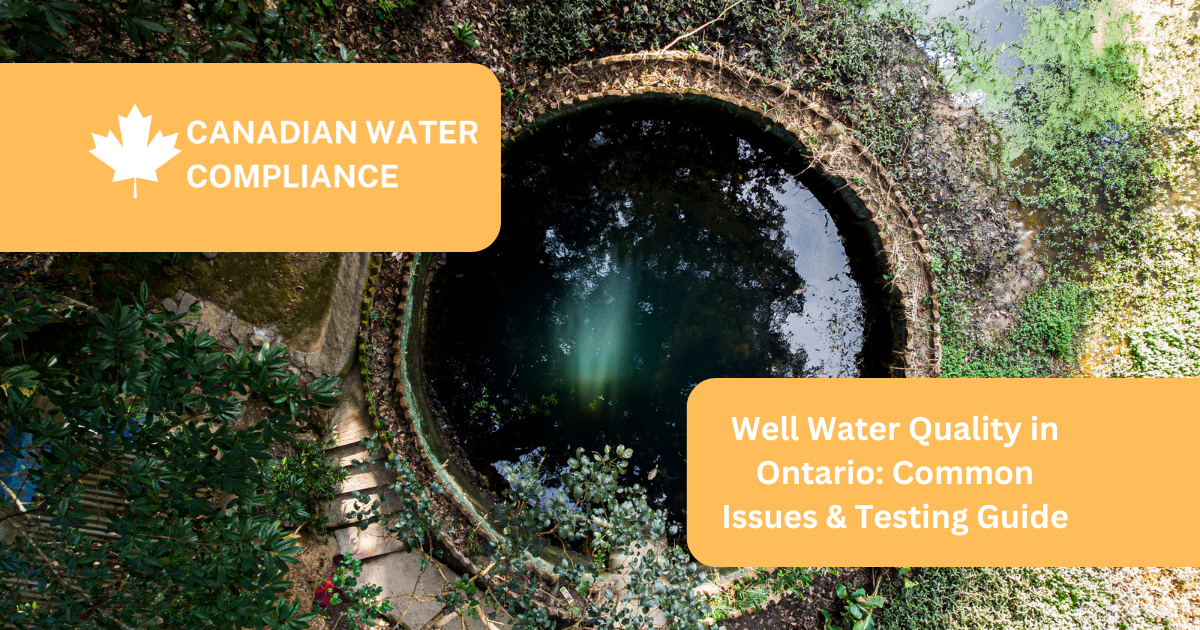
Written By: Canadian Water Compliance | On
For many Ontario residents, private wells serve as the primary source of drinking water. Unlike municipal systems, well water is not regulated by the government, meaning homeowners are responsible for testing and maintaining their own water quality. Without proper monitoring, well water can become contaminated with bacteria, heavy metals, nitrates, and other pollutants, posing serious health risks.
In this guide, we’ll cover:
Common well water quality issues in Ontario
Warning signs of contamination
Testing recommendations and frequency
Treatment options to ensure safe drinking water
Risk: Bacteria like E. coli and total coliforms can enter well water due to runoff from farms, septic system leaks, or animal waste.
Health Concerns: Gastrointestinal illness, diarrhea, and other infections.
Prevention: Regular well disinfection, proper well cap maintenance, and ensuring septic systems are functioning properly.
Risk: Agricultural fertilizers, septic systems, and industrial runoff can introduce high levels of nitrates into well water.
Health Concerns: High nitrate levels can cause blue baby syndrome (methemoglobinemia), which is particularly dangerous for infants.
Prevention: Testing at least twice a year for nitrates and avoiding fertilizer use near wells.
Risk: Naturally occurring minerals, old plumbing, and industrial activities can introduce metals into well water.
Health Concerns: Long-term exposure can lead to neurological damage, kidney issues, and developmental problems.
Prevention: Use of certified water filters and replacing old lead-based plumbing.
Risk: Many wells in Ontario contain high levels of calcium and magnesium, leading to hard water.
Health Concerns: Not a major health risk, but can cause scaling in pipes, damage appliances, and reduce soap effectiveness.
Prevention: Installing a water softener can help manage hardness levels.
Risk: Acidic or alkaline water can damage plumbing and leach metals like lead from pipes.
Health Concerns: Metallic taste, staining on sinks and toilets, and long-term plumbing issues.
Prevention: Testing pH levels and installing neutralizing filters if needed.
Risk: High hydrogen sulfide levels can produce a rotten egg smell, making water unpleasant to drink or use.
Health Concerns: Generally not harmful, but can corrode plumbing over time.
Prevention: Installing an aeration system or activated carbon filter can help remove sulfur odors.
Regular testing is the only way to ensure well water safety. The Government of Ontario recommends:
✅ Bacteria (E. coli & coliforms): At least three times a year (spring, summer, fall).
✅ Nitrates & Nitrites: Twice a year, especially in agricultural areas.
✅ Lead & Heavy Metals: Once a year or if plumbing materials may contain lead.
✅ Hardness, pH, & Sulfur: As needed if there are taste, odor, or scaling issues.
If well water tests reveal contamination, treatment solutions can help restore water quality:
UV Purification – Kills bacteria like E. coli and coliforms.
Reverse Osmosis Filters – Removes nitrates, heavy metals, and other dissolved contaminants.
Water Softeners – Reduces hardness by removing calcium and magnesium.
Activated Carbon Filters – Eliminates sulfur odors, chlorine, and organic pollutants.
Chemical Injection Systems – Used for treating high iron, manganese, and hydrogen sulfide levels.
Although private wells are not regulated, the Ontario government provides guidelines through the Safe Drinking Water Act, 2002 and local health units offer free well water testing for bacteria.
Ontario Regulation 903 (under the Water Resources Act) outlines well construction and maintenance requirements.
Local Public Health Units offer free well water testing for bacterial contamination.
The Ontario Ministry of the Environment, Conservation and Parks provides guidance on well safety and best practices.
Owning a private well in Ontario comes with the responsibility of regular testing and maintenance. Contaminants like bacteria, nitrates, heavy metals, and pH imbalances can compromise water safety. By following proper testing schedules, investing in filtration solutions, and staying informed about regulations, well owners can ensure their water remains safe and clean for everyday use.
🔎 Need professional well water testing? Contact Canadian Water Compliance today for expert testing and treatment solutions!